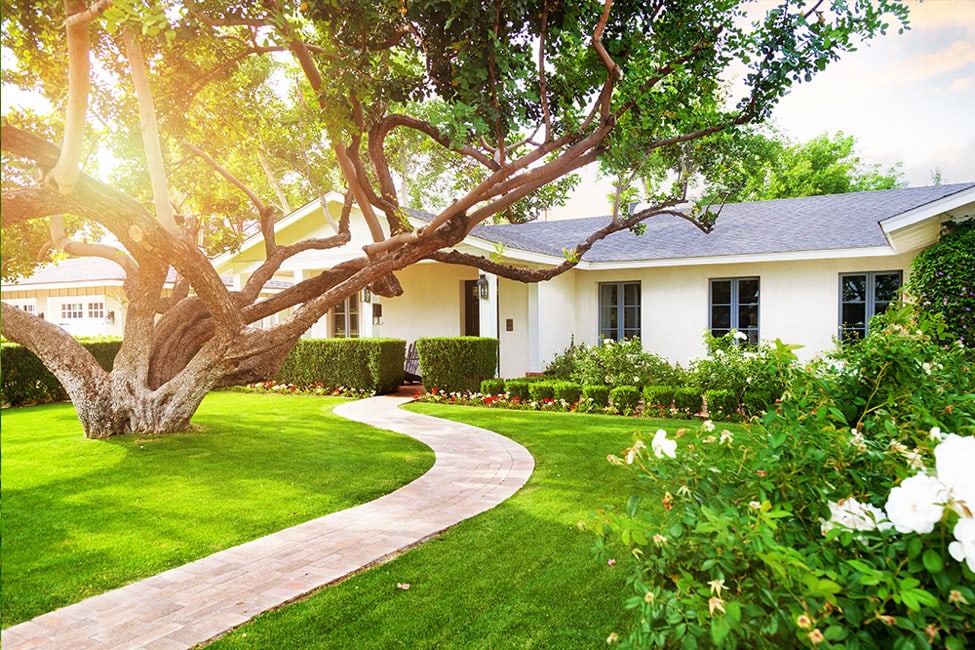Are the trees in your yard soaking up the summer sun? Read a few tips on how to water your trees so that they flourish throughout the season.


Are the trees in your yard soaking up the summer sun? Read a few tips on how to water your trees so that they flourish throughout the season.

But with the days only growing hotter, a regular watering schedule is essential to keep your trees happy and healthy.
Watering may sound simple, but each tree has unique needs depending on its species, age and location in the yard. In order to fully enjoy the benefits that trees offer your yard, such as providing a natural cooling effect and adding value to your home, it’s time to talk water. Let’s break down some of the trickier questions about keeping your trees in tip-top shape.
When it comes to deciding how much water to give your trees, there’s no standard amount that applies to every kind. Among the many influencing factors, whether the tree is newly planted or well-established can help you determine the right amount and technique.
It’s important to give new trees a warm welcome to your yard by providing all the water they need. During their growing season, new trees need more water than their well-established counterparts.
If weather conditions are particularly warm, you may find yourself watering these new trees once a week. Direct the water to the root ball, making sure it’s moist but not soggy. When receiving the perfect amount of hydration at the root ball, the new tree can perform its first step of growing its roots into the surrounding soil.
Summer can be a tough season for planting new trees. If you’re planning on a new addition in your yard, closely monitor the new tree to avoid transplant shock. Moving is an incredibly stressful experience for young trees, and the intense weather conditions of a summer planting can increase the risk of extensive damage to the root system. Keep an eye out for wilted, brown or yellow leaves. If you’re in need of an expert opinion on the condition of your new trees, TruGreen can help.
Established trees are typically low-maintenance when it comes to watering. But even if they’ve seen a season or two, staying hydrated is a vital component of their care.
As a general rule of thumb, the deep watering technique helps to keep your established trees quenched during a heat wave or a dry stretch. This technique keeps the tree roots from growing too shallow, and prevents the water from evaporating too quickly from the top layers of soil. Instead of covering a broad area, focus on slowly delivering the water 8-12 inches below the soil.
If you have questions about the deep watering technique and how it suits your trees, our specialists can help with an in-depth Tree & Shrub Evaluation®. The evaluation will help your TruGreen PhD-certified specialist determine the specific needs of your landscape.
Once you have the watering schedule established for your trees, it’s a good idea to regularly check the soil moisture to make sure you’re not over- or under-watering.
Sometimes, it’ll be easy to know if you’ve given your tree a bit too much water by simply feeling the top layer of soil. If it’s saturated and muddy, try easing up and letting the water soak into the soil. Go slow when watering to avoid excessive run-off, and give the moisture a chance to be absorbed.
But the topsoil isn’t always an accurate measure. Even if the top layer is dry, the deeper soil may already have enough moisture. A soil probe or screwdriver allows you to delve deeper and retrieve a more accurate sample for assessing moisture levels.
Other signs of overwatering include browning or wilting leaves, particularly in the lower levels of branches. If trees aren’t receiving quite enough water, you may notice damaged leaves that are dry and brittle.
Get summer started on the right track by consulting a TruGreen PhD-certified specialist who has the expertise to help your trees flourish. By putting together a tailored plan, our experts will keep your trees standing beautiful and tall, all season long.
To get started with your first TruGreen Tree & Shrub Evaluation®, call 800.464.0171 or visit our tree and shrub services page.

Facebook
X
Youtube
Copy Link
Email